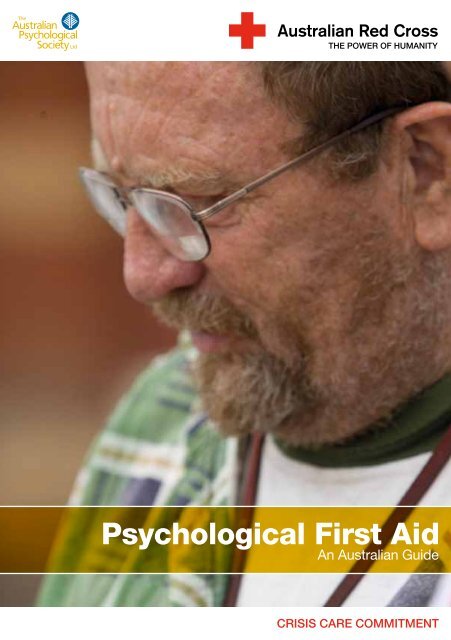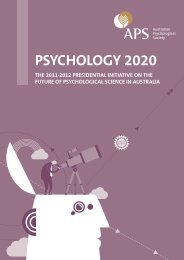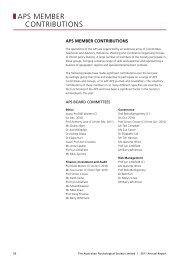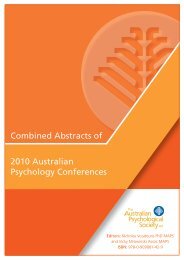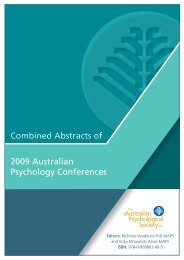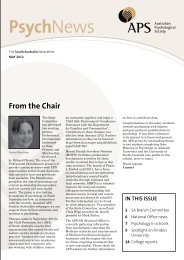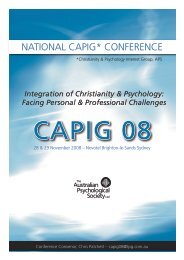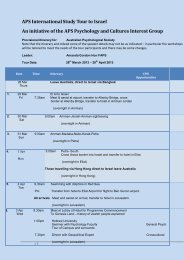Psychological First Aid: An Australian Guide
Psychological First Aid: An Australian Guide
Psychological First Aid: An Australian Guide
Create successful ePaper yourself
Turn your PDF publications into a flip-book with our unique Google optimized e-Paper software.
<strong>Psychological</strong> <strong>First</strong> <strong>Aid</strong><strong>An</strong> <strong>Australian</strong> <strong>Guide</strong>
<strong>An</strong> <strong>Australian</strong> <strong>Guide</strong> 01ContentsAcknowledgements 02Rationale 03Introduction 04What is psychological first aid? 06Who benefits from psychological first aid? 08What is psychological first aid aiming to achieve? 10Core principles 12Who delivers psychological first aid? 14What is psychological first aid aiming to achieve? 16What psychological first aid isn’t 17What are the core skills and action principlesrequired to deliver psychological first aid? 18What are the core competencies requiredto deliver psychological first aid? 20<strong>Psychological</strong> first aid training 20Useful organisations 22References 23
02 <strong>Psychological</strong> <strong>First</strong> <strong>Aid</strong>AcknowledgementsThis document was developed followingroundtable discussions on 15 December2009, co-hosted by <strong>Australian</strong> RedCross and the <strong>Australian</strong> <strong>Psychological</strong>Society. The roundtable was attendedby representatives of both organisations,the National Mental Health DisasterResponse Taskforce, <strong>Australian</strong> Centrefor Post traumatic Mental Health and theVictorian Department of Human Services.This guide is based on discussions atthe roundtable and material developed inthe United States by the National ChildTraumatic Stress Network (NCTSN) andNational Center for Posttraumatic StressDisorder, the Substance Abuse and MentalHealth Services Administration (SAMHSA)and the paper ‘Five essential elements ofimmediate and mid-term mass traumaintervention: Empirical evidence’ by StevanHobfoll and colleagues in 2007.This guide has been produced by the<strong>Australian</strong> <strong>Psychological</strong> Society and<strong>Australian</strong> Red Cross; the principalauthors were Dr Susie Burke, (<strong>Australian</strong><strong>Psychological</strong> Society) and Mr JohnRichardson (<strong>Australian</strong> Red Cross).The guide was informed by participantsat the roundtable and those that haveprovided subsequent comments,including:Professor Richard BryantUniversity of New South WalesMs Brigid ClarkeVictorian Department of HealthMr <strong>An</strong>drew Coghlan<strong>Australian</strong> Red CrossProfessor Mark Creamer<strong>Australian</strong> Centre for PostTraumatic Mental HealthMr Greg EustaceQueensland HealthDr Rob Gordon Consultant Psychologistto Department of Human Services Victoria,and <strong>Australian</strong> Red CrossMs Heather Gridley<strong>Australian</strong> <strong>Psychological</strong> SocietyDr Bob MontgomeryConsultant Psychologist, Past President<strong>Australian</strong> <strong>Psychological</strong> SocietyMs Charmaine O’Brien<strong>Australian</strong> Red CrossMs Sally Paynter<strong>Australian</strong> Red CrossProfessor Beverley RaphaelUniversity of Western Sydney andThe <strong>Australian</strong> National UniversityAssociate Professor Joseph ReserGriffith UniversityDr Kevin RonanUniversity of Central QueenslandMr Craig Wallace<strong>Australian</strong> <strong>Psychological</strong> SocietyDr Sally WoodingUniversity of Western Sydney
<strong>An</strong> <strong>Australian</strong> <strong>Guide</strong> 03RationaleThe purpose of this guide is to providean overview for people working indisaster preparedness, responseand recovery about best-practice inpsychological first aid following disastersand traumatic events. Each state andterritory has plans to deal with the healthconsequences of disasters. Includedin these plans are arrangements thatcover the mental health consequencesof emergencies. There are manytypes of psychological first aid and itis increasingly being used in the postdisaster context. There is an urgentneed for this technique to be givenan <strong>Australian</strong> context and packagedin a way that clearly outlines its aims,components, when PFA is used, whereit can be applied, and who benefits fromits use, and who can deliver it. This guidesets out to achieve this in a simple form.This guide complements work done bythe Disaster Response and ResilienceResearch Group at the University ofWestern Sydney. Dr Sally Wooding andProfessor Beverley Raphael have writtena chapter on psychological first aid thatprovides an overview of the field, takingthis guide a step further by explainingcore skills and basic action principles.At the time of printing, this chapter wasstill in draft format.This guide is also in line with resourcesdetailed in the Psychosocial Support inDisasters portal (www.psid.org.au).
<strong>An</strong> <strong>Australian</strong> <strong>Guide</strong> 05IntroductionEmergency is the genericterm used in Australia todescribe disruptive and/ordestructive events thatcause loss of life, propertyand livelihoods, injury, anddamage to communities.For the individual this maymean the loss of:• near or significant loved ones• control over one’s own life and future• hope and initiative• dignity• social infrastructure and institutions• access to services• property• livelihoods• place.After an emergency, people often loseconfidence in the norms, networks, andtrust in the society that is supposed toprotect them 1 .Until the late 1970s, the psychosocialaspect of emergencies was often ignoredas emergency management activitiesfocused on the actual rebuilding of townsdamaged by floods, fire or storms andhealing the wounds of those injured.Disaster mental health and theidentification of post-traumatic stressdisorder led to a shift in approachesto emergency management and tothe inclusion of disaster mental health.However, responses in this periodfocused on applying clinical mentalhealth skills in emergency settings,for which they were never intended.It was then recognised that mostpeople did not develop serious mentalhealth issues after emergencies, andwith some basic support the majorityof people would recover well. This ledto the development of psychologicalfirst aid as a primary tool after anemergency. It has also been recognisedboth in Australia and internationally thatpsychosocial support in emergencies isbest delivered as a community-basedactivity, rather than within a medicalhealth system 2 .Providing coordinated psychosocialsupport in emergencies has now becomea critical part of preparing for, respondingto and recovering from an emergency.1For more information see IFRC 2009.2For more information see IASC 2007; IFRC 2009;van Ommeran, Saxena & Saraceno 2005.
06 <strong>Psychological</strong> <strong>First</strong> <strong>Aid</strong>What is psychologicalfirst aid?<strong>Psychological</strong> first aidis a proven approach tohelping people affectedby an emergency, disasteror traumatic event.<strong>Psychological</strong> first aidis based on the principleof ‘do no harm’.It includes basic commonsenseprinciples of support to promote normalrecovery, such as helping people tofeel safe, connected to others, calmand hopeful, with access to physical,emotional and social support, and ableto help themselves 3 . <strong>Psychological</strong> firstaid aims to reduce initial distress, meetcurrent needs, promote flexible copingand encourage adjustment.<strong>Psychological</strong> first aid is useful asthe first thing that you might do withindividuals or families following a disaster.It is most widely used in the first hours,days and weeks following an event.<strong>Psychological</strong> first aid is based on anunderstanding that people affectedby disasters will experience a range ofearly reactions (physical, psychological,emotional, behavioural) that may interferewith their ability to cope 4 .3For more information see Hobfoll et al. 2007.4For more information see Brymer et al. 2006.These reactions are normal andunderstandable given people’sexperiences. In this situation, recoverymay be helped by psychological first aid.For a small part of an affected population,further support and mental health supportmay be necessary to assist recovery, butmost people recover well on their own, orwith the support of compassionate andcaring disaster workers, family and friends.While psychological first aid is mostcommonly used immediately after adisaster, its use is not limited to this timeperiod. Sometimes the first contactpeople have with psychological first aidcomes months or even years after theemergency. Outreach visits conductedby Red Cross nine months after the2009 Victorian bushfires, for example,was the first time many people receivedpsychological first aid. <strong>Psychological</strong> firstaid skills can also be applied to publicinquiries and anniversaries of emergenciesor traumatic events, all of which may takeplace years after the event.<strong>Psychological</strong> first aid has a longhistory 5 , but has become more popularfollowing research showing the dangersof critical incident stress debriefing 6 .Since 2002, psychological first aid hasbeen recommended as a key part ofthe provision of psychosocial supportfollowing disasters.5For more information see Drayer, Cameron, Woodward& Glass 1954; Raphael 1977a&b and 1986.6For more information see National Institute of MentalHealth 2002; Rose, Bisson & Wessley 2003; Bisson,Brayne, Ochberg & Everly 2007; Bisson & Lewis 2009.
<strong>An</strong> <strong>Australian</strong> <strong>Guide</strong> 07“<strong>Psychological</strong> first aidis a human, caring andcompassionate responsethat addresses practicalneeds and concernsabove all else”
08 <strong>Psychological</strong> <strong>First</strong> <strong>Aid</strong>
<strong>An</strong> <strong>Australian</strong> <strong>Guide</strong> 09Who benefitsfrom psychologicalfirst aid?While the sudden disruptive nature ofemergencies means that we are allexposed to uncertainty and stress,people will experience different degreesof distress. Whenever possible, anyperson in distress should have accessto psychological first aid. This includesadults, adolescents and children, aswell as disaster relief workers and firstresponders.How people respond and copedepends on a variety of factors,including their experience of theemergency, their health, their personalhistory and their available supports.Some people may be at more risk ofnegative consequences. These mayinclude those people who:• have had previous traumaticexperience• have underlying mental illnesses• were exposed to events where thehorror element was high• thought they were going to die• experienced traumatic bereavement• have had serious losses of property,livelihoods, or disruption tocommunities and networks.There will also be some situationswhere people need more care than canbe provided by psychological first aidand need to be immediately referred toother people and services that providespecialised support. This includespeople who are:• seriously injured and needingemergency medical care• so distressed that they are unable toperform the basic activities of daily life• threatening harm to themselves orothers.It is important also to remember thatnot everyone who experiences anemergency will have emotional distressor problems during or after the crisis.Not everyone who experiences a crisiswill need psychological first aid. Someprotecting factors include 7 :• good level of functioning• social support• ability to cope• strong moral belief systems• returning to normal life (i.e. reducingdisruption).7For more information see Johns Hopkins School ofPublic Health & IFRC 2008.
10 <strong>Psychological</strong> <strong>First</strong> <strong>Aid</strong>What is psychologicalfirst aid aiming toachieve?<strong>Psychological</strong> first aidis human, caring andcompassionate, andaddresses practicalneeds and concernsabove all else.<strong>An</strong> important aim of psychologicalfirst aid is to build people’s capacityto recover by helping them to identifytheir immediate needs, and their ownstrengths and abilities to meet theseneeds. One of the most importantfindings in the literature is that one’sbelief in their ability to cope can predictthe outcome. Those who are optimistic,positive and feel confident that life andself are predictable, or they displayother hopeful beliefs, typically, do betterafter experiencing mass trauma 8 .The goals of psychological first aidinclude efforts to:• calm people• reduce distress• make people feel safe and secure• identify and assist with current needs• establish human connection• facilitate people’s social support• help people understand the disasterand its context• help people identify own strengthsand abilities to cope• foster belief in people’s ability to cope• give hope• assist with early screening for peopleneeding further or specialised help• promote adaptive functioning• get people through the first period ofhigh intensity and uncertainty• set people up to be able to naturallyrecover from an event• reduce the chance of post traumaticstress disorder.8For more information see Carver 1999, Ironson et al.1997, Solomon 2003.
<strong>An</strong> <strong>Australian</strong> <strong>Guide</strong> 11
12 <strong>Psychological</strong> <strong>First</strong> <strong>Aid</strong>Core principles<strong>Psychological</strong> first aid is not prescriptive.However, there are basic elements toproviding psychological first aid that havebeen drawn from the literature on riskand resilience, research, field experienceand expert agreement 9 .The core principles of psychological firstaid are to promote:• safety• calm• connectedness• self-efficacy and group efficacy• hope• help.Each of these principles has developedinto key strategies 10 .Promote safety• Remove from or reduce exposureto threat of harm.• Help people meet basic needs forfood, water, shelter, financial andmaterial assistance and obtainemergency medical attention.• Provide physical and emotional comfort.• Provide repeated, simple and accurateinformation, in a range of methods, onhow to get these basic needs.9For more information see Hobfoll et al. 2007, IFRC2009, SAMHSA 2010, Queensland Health (2008).10For more information see the NCTSN, National Centerfor PTSD and SAMHSA websites.
<strong>An</strong> <strong>Australian</strong> <strong>Guide</strong> 13Promote calm• Stabilise people who areoverwhelmed or disoriented.• Provide an environment, as faras practical, that is removed fromstressful situations or exposure tosights, sounds and smells of theemergency.• Listen to people who wish to sharetheir stories and emotions, withoutforcing them to talk.• Remember that there is no rightor wrong way to feel.• Be friendly and compassionate evenif people are being difficult.• Offer accurate information aboutthe disaster or trauma and the reliefefforts underway to help survivorsunderstand the situation.Promote connectedness• Help people contact friendsand loved ones.• Keep families together.• Keep children with parents or otherclose relatives whenever possible.• Help establish contacts with supportpeople (friends, family or communityhelping resources).• Respect cultural norms regardinggender, age and family structures.Promote self-efficacy• Engage people in meeting theirown needs.• Assist with decision making, help themto prioritise problems and solve them.• Reassure people that their feelingsare normal.Promote help• Find out the types and locations ofgovernment and non-governmentservices.• Provide information and direct peopleto those services that are available.• Link people with available services.• When they express fear or worry,remind people (if you know) that morehelp and services are on the way.• Offer practical help to people to addressimmediate needs and concerns.• Provide information on stressand coping.Promote hope• Convey expectancy that peoplewill recover.• Be there/be willing to help.
14 <strong>Psychological</strong> <strong>First</strong> <strong>Aid</strong>Who deliverspsychologicalfirst aid?<strong>Psychological</strong> first aidshould be delivered byappropriate agencies aspart of state, regional/district or local emergencymanagement plans.This means responses can be undertakenin a coordinated manner, and thatpsychosocial support can be provided asa key part of the emergency response.In Australia, this could include: healthand allied health professionals, teachersand other education professionals,members of the clergy and otherfaith-based organisations, Red Crosspersonal support volunteers and othertrained responders from communityorganisations, and local government staff.The principles of psychological firstaid, however, also mean that it canbe offered by a wide variety of peoplein the community – from emergencypersonnel to neighbours and volunteers– in addition to trained responders.<strong>Psychological</strong> first aid is a humane,supportive and practical responseto people who have been exposedto serious stresses and may needsupport 11 . Most people responding toan emergency are able to provide thistype of assistance, comfort and supportto people in distress 12 . The principles ofpsychological first aid are, therefore, animportant grounding for all emergencypersonnel responding to an emergency.While their primary focus will be onresponding to the emergency, thesepeople are usually the first contactsurvivors have with the ‘system’, andthey have an important role to play inassisting in safe and effective ways thatpromote recovery.It is useful to differentiate betweengeneral psychological and personalsupport and the way all emergencyresponders help in responsibleways – ways that respect the dignityand capacity of survivors –, andpsychological first aid as a servicedelivered by trained responders whoseprimary role is to protect and promotemental health and psychosocialwellbeing.11For more information see IASC 2007.12For more information see WHO 2010.
<strong>An</strong> <strong>Australian</strong> <strong>Guide</strong> 15
16 <strong>Psychological</strong> <strong>First</strong> <strong>Aid</strong>Where is psychologicalfirst aid delivered?<strong>Psychological</strong> first aid can be deliveredin diverse settings. <strong>Psychological</strong> firstaid could be delivered at the sceneof the emergency or at places whereaffected people gather, such as:• evacuation centres• recovery centres• hospitals• humanitarian assistance centres• homes• schools• businesses• shopping centres• airports and• train stations• memorial services• community centres.
<strong>An</strong> <strong>Australian</strong> <strong>Guide</strong> 17What psychologicalfirst aid isn’tIt is important to clarify what psychologicalfirst aid isn’t, and to differentiate it fromearlier forms of post-disaster support,most notably critical-incident stressdebriefing. <strong>Psychological</strong> first aid is:• NOT debriefing• NOT obtaining details of traumaticexperiences and losses• NOT treating• NOT labelling or diagnosing• NOT counselling• NOT something that onlyprofessionals can do• NOT something that everybody whohas been affected by an emergencywill need.Post-emergency settings are not clinicalenvironments and it is inappropriateto conduct a clinical or psychologicalassessment within the setting.It is important to limit contact at thispoint to simple support, as outlinedby psychological first aid. Peoplewho display marked signs of risk (e.g.suicidal tendencies) should be referredto formal mental health services.It is not useful – and may be harmful –to directly encourage a disaster survivorto discuss their responses initially.If a person wants to discuss theirexperiences, it is useful to provide themwith support but only in a way that doesnot push them to discuss more thanthey want 13 .13For more information see Watson et al. 2002;Ruzek et al. 2007; McNally, Bryant, & Ehlers 2003.
18 <strong>Psychological</strong> <strong>First</strong> <strong>Aid</strong>What are the coreskills and actionprinciples required todeliver psychologicalfirst aid?Disaster response organisations thatoffer training in psychological first aiddefine sets of core skills and actionprinciples as part of their manuals 14 .These vary from one organisationto another. Wooding & Raphael 15provide a useful summary of the coreskills defined by leading disasterresponse organisations and makerecommendations about the core skillsfor Australia.14For more information see Brymer et al 2006,Stevens & Raphael 2008a&b, WHO 2010.15For more information see Wooding & Raphael 2010.,Queensland Health (2008).
<strong>An</strong> <strong>Australian</strong> <strong>Guide</strong> 19Core skills and action principles in the <strong>Australian</strong> contextBe preparedBe prepared: know the situation, who your teammembers are and who is in charge; have a basicfirst-aid qualification.Assess and prioritiseAssess and prioritise: assess the situation and prioritiseneed; don’t rush in.Safety, security and shelterSafety, security and shelter: ensure people are warm,protected and have access to water or other suitabledrinks etc.EngagementEngagement: make contact, introduce yourself in a nonintrusiveway, explain who you are and why you are there.Calming and ComfortingCalming and Comforting: ‘be’ with people, acknowledgetheir situation, validate their thoughts and feelings; practicalstrategies (breathing, grounding techniques) to calm.Practical assistancePractical assistance: what is their most pressingconcern? How can you help with this? Whatinformation is available to them?Finding solutionsFinding solutions: encouraging people to identify their needsand consider ways of meeting them, help them to do this orfind information/relevant people who can assist.Moving on to assist othersMoving on to assist others: ensuring that linkages havebeen established for the previous person and then movingon, once again, to assess for greatest need.
20 <strong>Psychological</strong> <strong>First</strong> <strong>Aid</strong>What are the corecompetenciesrequired to deliverpsychologicalfirst aid?In addition to knowledge about coreskills and action principles, individualsand organisations offering psychologicalfirst aid need some core competenciesto effectively support others.The core competencies include:• understanding of the disaster context• ability to stay calm and focused• listening skills• communication skills• warmth, empathy and compassionfor others• flexibility• problem solving skills• knowledge about how to providepractical help• self-care for helpers 16 .<strong>Psychological</strong>first aid trainingTraining for respondersVarious psychological first aid trainingprograms are offered across Australia,some provided by independent (oftenprivate) organisations selling the courses,and others run within organisations fortheir own staff. None of these programsare accredited and the content of thesecourses varies across organisations.Some quality international trainingprograms are currently being trialledfor psychological first aid respondersby organisations such as the <strong>Australian</strong>Centre for Posttraumatic MentalHealth, Red Cross (both the ICRC andIFRC), National Child Traumatic StressNetwork (US) and the World HealthOrganization1. These programs varywidely and cannot be easily compared.Usually, psychological first aid trainingfollows a set of principles, but isadapted to the specific needs of thegroup being trained. Some trainingmodels are being developed for deliveryvia the internet, for example:• NCTSN (http://learn.nctsn.org/index.php) offers a six-hour psychologicalfirst aid course online16The Psychosocial Support in Disasters portal(www.psid.org.au) provides links to furtherinformation about psychological first aid skills,competencies and training information.
<strong>An</strong> <strong>Australian</strong> <strong>Guide</strong> 21In order to provide a competentworkforce, the authors of this manualstrongly recommend that an introductionto psychological first aid be a standardpart of the training and briefing of trainedresponders working in an emergencyin a variety of capacities. The basicprinciples of psychological first aid canbe helpful for all trained responders.It can help them to comfort and calmsurvivors, do no harm and look afterthemselves. A basic introduction shouldbe given by people who are experiencedin the delivery of psychological first aidand in emergency settings. It could takea few hours or a half-day.More advanced training in psychologicalfirst aid is recommended for people whoare working, or intend working, in anemergency situation with the specifictask of meeting people’s psychosocialsupport needs. A one-day training, atleast, is recommended, to both providean introduction to psychological first aidas well as detailed information abouthow to apply psychological first aid in thecontext in which someone is working.Training for the publicAs well as training people who areworking in disasters in how to deliverpsychological first aid, there are alsoprograms that teach the general publicthe basic skills of psychological firstaid. Some disaster mental healthexperts maintain that the effect ofpsychological first aid is related tothe extent to which it has spreadthroughout the population 17 . The aim isto deliver psychological first aid trainingwidely throughout communities thatare vulnerable to disasters. The corecomponents of community-basedpsychological first aid training includeskills like 18 :• understanding traumatic stress• active listening skills• how to make referrals and when• self-care.17For more information see Jacobs 2010.18For more information see Jacobs 2010; ACPMH 2009.
22 <strong>Psychological</strong> <strong>First</strong> <strong>Aid</strong>Useful organisations<strong>Australian</strong> Child & Adolescent Trauma,Loss & Grief Network (ACATLGN)www.earlytraumagrief.anu.edu.au<strong>Australian</strong> Centre for PosttraumaticMental Health (ACPMH)www.acpmh.unimelb.edu.au<strong>Australian</strong> <strong>Psychological</strong> Society (APS)www.psychology.org.au<strong>Australian</strong> Red Crosswww.redcross.org.aubeyondbluewww.beyondblue.org.auDepartment of Human Services (DHS),State Government of Victoriawww.dhs.vic.gov.au/emergencyDepartment of Health (Queensland)www.health.qld.gov.au/mentalhealth/useful_links/disaster.aspDisaster Response andResilience Research Group,University of Western Sydneywww.uws.edu.au/disaster_response_resilience/disaster_response_and_resilienceEmergency Management In Australiawww.ema.gov.auInter-Agency Standing Committee (IASC)www.humanitarianinfo.org/iascInternational Committee of theRed Cross (ICRC)www.icrc.orgInternational Federation of Red Crossand Red Crescent Societies (IFRC),Psyho-social Support Reference Centrehttp://psp.drk.dkNational Center for PTSDwww.ncptsd.va.govNational Child Traumatic StressNetwork (NCTSN)www.nctsn.orgNational Institute of Mental Health (NIMH)www.nimh.nih.govPsychosocial Support in Disasters Portalwww.psid.org.auSphere Project for Minimum Standardsin Humanitarian Responsewww.sphereproject.orgSubstance Abuse and Mental HealthServices Administration (SAMHSA)www.samhsa.govWorld Health Organization (WHO)www.who.int
<strong>An</strong> <strong>Australian</strong> <strong>Guide</strong> 23ReferencesACPMH 2009, Community RecoveryFollowing Disaster: Training forCommunity Support People –Workshop <strong>Guide</strong> and Resource,<strong>Australian</strong> Centre for PosttraumaticMental Health & beyondblue,Melbourne, Australia.Bisson, JI, Brayne, M, Ochberg, FM &Everly, GS 2007, ‘Early psychologicalintervention following traumatic events’,American Journal of Psychiatry, vol.164, pp. 1016–19.Bisson, JI & Lewis, C 2009, SystematicReview of <strong>Psychological</strong> <strong>First</strong> <strong>Aid</strong>,commissioned by the World HealthOrganization.Brymer, M, Jacobs, A, Layne, C,Pynoos, R, Ruzek, J, Steinberg,A, Vernberg, E & Watson, P 2006,<strong>Psychological</strong> <strong>First</strong> <strong>Aid</strong> – FieldOperations <strong>Guide</strong>, 2nd edn, NationalChild Traumatic Stress Network &National Center for PTSD, USA.Carver, C 1999, ‘Resilience and thriving:Issues, models and linkages’, Journal ofSocial Issues, vol. 54, pp. 245–66.Drayer, CS, Cameron, DC, Woodward,WD & Glass, AJ 1954, ‘<strong>Psychological</strong>first aid in community disaster’. Journalof American Medical Association, vol.156, 1, pp. 36–41.Hobfoll, SE, Watson, P, Bell, CC,Bryant, RA, Brymer, MJ, Friedman, MJet al. 2007, ‘Five essential elements ofimmediate and mid-term mass traumaintervention: Empirical evidence’,Psychiatry, vol. 70, pp. 283–315.International Federation of Red Crossand Red Crescent Societies (IFRC) 2009,Psychosocial Handbook, InternationalReference Centre for PsychosocialSupport, Copenhagen, Denmark.Inter-Agency Standing Committee (IASC)2007, IASC <strong>Guide</strong>lines on Mental Healthand Psychosocial Support in EmergencySettings, IASC, Geneva, Switzerland.Ironson, G, Wynings, C, Schneiderman,N, Baum, A, Rodriguez, M, Greenwood,D et al. 1997, ‘Post-traumatic stresssymptoms, intrusive, thoughts, loss,and immune function after Hurricane<strong>An</strong>drew’, Psychosomatic Medicine, vol.59, pp. 128–41.Jacobs, G 2010, Roundtable discussionbetween Professor Jerry Jacobsand various <strong>Australian</strong> emergencymanagement experts, 19 July 2010,<strong>Australian</strong> <strong>Psychological</strong> Society,Melbourne, Australia.Johns Hopkins Bloomberg School ofPublic Health & International Federationof Red Cross and Red Crescent Societies2008, Public Health <strong>Guide</strong> in Emergencies,2nd edn, Geneva, Switzerland.
24 <strong>Psychological</strong> <strong>First</strong> <strong>Aid</strong>McNally, R, Bryant, R & Ehlers, A 2003,‘Does early psychological interventionpromote recovery from posttraumaticstress?’, <strong>Psychological</strong> Science in thePublic Interest, vol. 4, pp. 45–79.National Institute of Mental Health 2002,Mental Health and Mass Violence –Evidence-based early <strong>Psychological</strong>Intervention for Victims/Survivors ofMass Violence, NIMH publication No.02-5138, US Government PrintingOffice, Washington DC, USA.Queensland Health (2008) <strong>Psychological</strong><strong>First</strong> <strong>Aid</strong> Core Actions EmergencyManagement Unit Fact Sheet.Raphael, B 1977a, ‘Preventiveintervention with the recently bereaved’Archives of General Psychiatry, vol. 34,pp. 1450–4.Raphael, B 1977b, ‘The Granville traindisaster: <strong>Psychological</strong> needs andtheir management’, Medical Journal ofAustralia, vol. 1, pp. 303–5.Raphael, B 1986, When Disaster Strikes– How Individuals and CommunitiesCope with Catastrophe, Basic Books,New York, USA.Raphael, B, Stevens, G & Taylor,M 2009, Disaster Response andResilience Research Group, Universityof Western Sydney, Australia.Rose, S, Bisson, J & Wessley, S2003, ‘A systematic review of singlepsychological interventions (‘debriefing’)following trauma – Updating theCochrane review and implicationsfor good practice’, in RJ Orner & USchnyder (eds) Reconstructing EarlyIntervention after Trauma Innovations inthe Care of Survivors, pp. 24–9, OxfordUniversity Press, Oxford, UK.Ruzek, JI, Brymer, MJ, Jacobs, AK,Layne, CM, Vernberg, EM & Watson, PJ2007, ‘<strong>Psychological</strong> first aid’, Journalof Mental Health Counseling, vol. 29,pp. 17–49.Solomon, Z 2003, Coping with War-Induced Stress – The Gulf War and theIsraeli Response, Plenum, New York, USA.Stevens, G & Raphael, B 2008a,CBRN SAFE: Psychosocial Guidancefor Emergency Workers – Chemical,Biological, Radiological & NuclearIncidents, University of WesternSydney, Australia.Stevens, G & Raphael, B 2008b,CBRN SAFE – Incident Pocket <strong>Guide</strong>,University of Western Sydney, Australia.Substance Abuse and Mental HealthServices Administration (SAMHSA)2007, <strong>Psychological</strong> <strong>First</strong> <strong>Aid</strong> – A <strong>Guide</strong>for Emergency and Disaster ResponseWorkers, US Department of Health andHuman Services, Washington, DC, USA.
<strong>An</strong> <strong>Australian</strong> <strong>Guide</strong> 25Substance Abuse and Mental HealthServices Administration (SAMHSA)2010, <strong>Psychological</strong> <strong>First</strong> <strong>Aid</strong> for <strong>First</strong>Responders – Tips for Emergency andDisaster Response Workers(http://store.samhsa.gov/home).van Ommeran, M, Saxena, S &Saraceno, B 2005, ‘Mental andsocial health during and after acuteemergencies – Emerging consensus?’,Bulletin of the World HealthOrganization, vol. 83, pp. 71–6.Watson, PJ, Friedman, MJ, Ruzek JI &Norris, FH 2002, ‘Managing acute stressresponse to major trauma’, CurrentPsychiatry Reports, vol. 4, pp. 247–53.World Health Organization (WHO) 2010,Helping in Crisis Situations in Low andMiddle Income Countries <strong>Guide</strong> to<strong>Psychological</strong> <strong>First</strong> <strong>Aid</strong> – currently in draft.Wooding, S & Raphael, B 2010.<strong>Psychological</strong> <strong>First</strong> <strong>Aid</strong> – Level 1Intervention Following Mass Disaster,University of Western Sydney, Australia.Young, B 2006, ‘The immediateresponse to disaster – <strong>Guide</strong>lines foradult psychological first aid’, in ECRichie, PJ Watson & MJ Friedman (eds)Interventions Following Mass Violenceand Disasters – Strategies for MentalHealth Practices, pp. 134–54, GilfordPress, New York, USA.
<strong>Australian</strong> <strong>Psychological</strong> SocietyLevel 11, 257 Collins Street,Melbourne VIC 3000Phone: (03) 8662 3300Toll free: 1800 333 497www.psychology.org.au<strong>Australian</strong> Red CrossNational Office155 Pelham Street,Carlton VIC 3053Phone: (03) 9345 1800www.redcross.org.au


